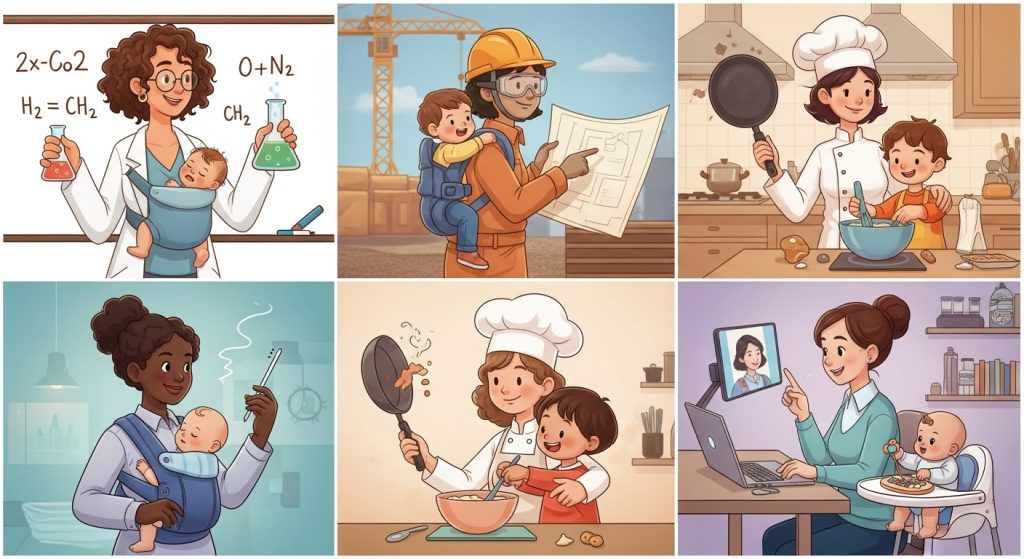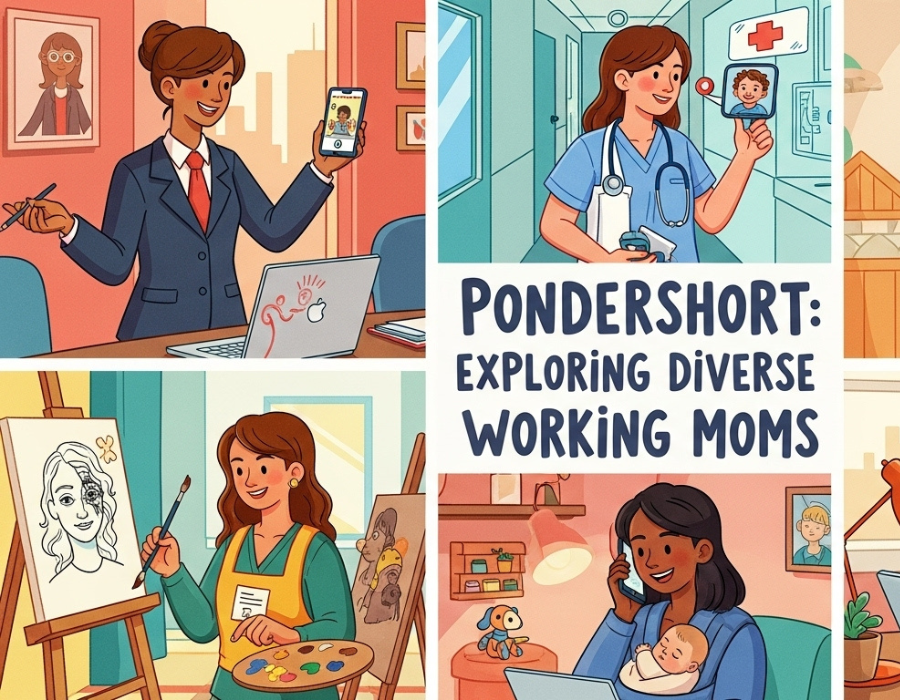In today’s ever-changing world, the image of a “working mom” has evolved far beyond the traditional boundaries of home and office. Through Pondershort: Exploring Diverse Working Moms, we dive deep into the real stories, struggles, and triumphs of mothers balancing their professional ambitions with family life. This exploration is not just about statistics—it’s about human experience, emotional resilience, and the beauty of modern motherhood.
Understanding Pondershort and Its Focus
Before diving in, let’s understand what Pondershort stands for. It’s not just a platform—it’s a thoughtful reflection on modern social trends and experiences. In this context, Pondershort explores the world of diverse working moms—mothers from different backgrounds, professions, and cultures who share one thing in common: their ability to adapt and thrive in multiple roles.
Motherhood has never been one-size-fits-all, and Pondershort’s exploration reminds us that every working mom’s story is a piece of a larger mosaic—vivid, challenging, and inspiring.
Who Are the “Diverse Working Moms”?
When we talk about diverse working moms, we mean mothers who come from various cultural, economic, and professional backgrounds. Some work full-time corporate jobs; others manage small businesses, freelance, or work remotely.
Diversity among working moms also includes single mothers, mothers with disabilities, and those from minority or underrepresented communities. Each carries unique challenges and strengths that shape their motherhood journey differently.
The Changing Face of Modern Motherhood
Gone are the days when motherhood meant leaving the workforce. Today, mothers contribute to every field imaginable—tech, healthcare, education, and entrepreneurship. Remote work and flexible schedules have also made it possible for more women to balance family and professional life effectively.
In 2025, working moms are redefining success—not by the hours spent at a desk but by the impact they create both at home and in society.
The Daily Juggle: Work–Life Balance
Balancing a career and family is like walking a tightrope while juggling flaming torches. Working mothers often find themselves split between deadlines and diapers, meetings and meal preps.
The Mental Load
Beyond visible chores, moms carry a “mental load”—planning meals, remembering appointments, tracking school projects, and managing emotional needs. It’s an invisible but heavy burden. And yet, they continue, often without recognition.
The Struggle for Time
There’s never enough time. A working mom’s day begins before sunrise and ends long after everyone else has gone to bed. From preparing breakfast to managing client calls, their 24 hours stretch thinner than most people realize.
Facing Bias and Barriers
Despite progress, working moms still face social and workplace barriers. The “motherhood penalty”—a term used to describe how mothers are often perceived as less dedicated or competent at work—remains a real issue.
Workplace Discrimination
Many mothers face subtle discrimination—missed promotions, fewer opportunities, or assumptions that they can’t handle demanding roles. Some workplaces are still structured around the outdated idea that the “ideal worker” has no caregiving responsibilities.
Lack of Institutional Support
Affordable childcare and family-friendly policies are not accessible everywhere. Inflexible schedules, limited maternity leave, and lack of reentry programs make it harder for women to maintain long-term careers after childbirth.
Emotional Challenges of Working Moms
Beyond professional struggles, there are emotional battles that mothers often fight silently.
The Guilt Trap
Many mothers feel torn between their children and their jobs. They question whether they’re doing enough for their kids—or enough for their careers. This constant guilt can be draining.
Stress and Burnout
Balancing everything often leads to exhaustion. Burnout is common among working moms who rarely take time for themselves. Without support systems, the pressure can take a toll on both mental and physical health.
The Strengths of Working Moms
Despite challenges, working moms possess remarkable strengths that make them stand out—not just as parents but as professionals and leaders.
Multitasking Masters
Working mothers are expert jugglers. They switch between roles effortlessly—professional, caregiver, mentor, and friend—often multiple times a day. This ability sharpens their organizational and time management skills.
Empathy and Resilience
Having faced countless personal and professional hurdles, mothers develop deep empathy and resilience. They lead with compassion and emotional intelligence—qualities that make workplaces stronger and more inclusive.
Role Models for the Next Generation
When children see their mothers balancing both family and career, they learn vital lessons about equality, discipline, and determination. Studies show that children of working mothers often grow up more independent and career-driven.

Opportunities and Corporate Inclusion
Thankfully, times are changing. Many organizations are realizing the immense value that working moms bring to the table.
Flexible Work Policies
Companies adopting flexible work arrangements—like remote work, hybrid schedules, or flexible hours—are helping mothers manage both work and family efficiently.
Returnship Programs
“Returnship” initiatives are becoming popular. These are programs designed to help women reenter the workforce after a career break, offering them training, mentorship, and confidence-building opportunities.
Childcare Support
Onsite childcare or financial childcare support allows working mothers to focus on their careers without constant worry. This not only benefits employees but also boosts overall productivity and loyalty.
Strategies for Working Moms
While companies can do much, working moms also develop personal strategies to make life smoother.
Setting Boundaries
Learning to say “no” when needed and setting work-life boundaries are crucial for mental health. It’s okay not to be available 24/7.
Prioritizing Self-Care
Even small self-care habits—like meditation, walks, or simply having a cup of tea in silence—can recharge energy and emotional balance.
Building Support Networks
Connecting with other working mothers through online groups or local communities provides emotional and practical support. Shared experiences help moms feel understood and less isolated.
Social and Policy-Level Support
Governments and societies play an equally vital role in supporting working moms.
Legal Protections and Leave Policies
Paid maternity leave, paternity leave, and workplace protections help mothers return to work without sacrificing their well-being or financial stability.
Affordable Childcare Infrastructure
Publicly funded childcare systems enable women to stay employed without draining household income. It’s an investment in families—and the economy.
Cultural Shift Toward Equality
Society must recognize caregiving as shared responsibility. Encouraging fathers to take active roles helps break stereotypes and lighten the mental and physical load on mothers.
Real Stories: Working Moms Around the World
Let’s hear from some inspiring examples of working moms:
-
Maria, a software developer from Spain, works remotely and manages two young kids while leading her tech team. She believes flexibility is the new empowerment.
-
Ayesha, a single mother from Pakistan, runs an online clothing business while homeschooling her daughter. Her story is one of resilience and determination.
-
Nina, a nurse from Canada, balances night shifts with family duties. Her story reflects sacrifice and strength that keep communities thriving.
Every story proves that there’s no single “right” way to be a working mom—only the courage to keep going.
The Future of Working Motherhood
Looking ahead to 2025 and beyond, the concept of motherhood continues to evolve alongside technology and culture.
The Role of Technology
With AI, digital tools, and remote collaboration, working moms can now operate businesses, attend meetings, and manage families—all from one device. Technology has become an equalizer.
Inclusive Workplaces
Companies are now prioritizing diversity, equity, and inclusion (DEI) programs that consider motherhood as part of the inclusion narrative. This shift ensures that workplaces support—not penalize—mothers.
Changing Generational Perspectives
Younger generations are reshaping work culture. They value flexibility, family time, and emotional well-being over traditional 9-to-5 ideals. This evolution promises a more supportive world for future mothers.
Conclusion
Exploring diverse working moms through Pondershort gives us a heartfelt look into what it truly means to balance ambition and care in the modern world. These mothers are not just workers or caregivers—they’re leaders shaping future generations.
By recognizing their struggles, celebrating their strengths, and pushing for fair systems, we create a world where being a mom and a professional are no longer competing roles—they’re complementary ones. Every working mother deserves respect, support, and space to thrive—because when mothers rise, society rises with them.
FAQs
1. What does “Pondershort: Exploring Diverse Working Moms” focus on?
It focuses on understanding the real-life experiences, challenges, and triumphs of mothers from different backgrounds who balance both career and family responsibilities.
2. Why is diversity important when discussing working moms?
Because no two mothers share the same circumstances. Cultural, economic, and personal differences shape how each mom experiences motherhood and work-life balance.
3. What are the biggest challenges working moms face today?
Key challenges include managing time, overcoming workplace bias, limited childcare options, and balancing emotional well-being with professional goals.
4. How can employers better support working moms?
Employers can implement flexible schedules, remote work options, mentorship programs, childcare support, and fair promotion systems to ensure equality and inclusion.
5. What’s the future outlook for working moms in 2025 and beyond?
The future looks more inclusive and flexible, with technology enabling better work-life integration, supportive policies, and a global shift toward shared caregiving roles.


